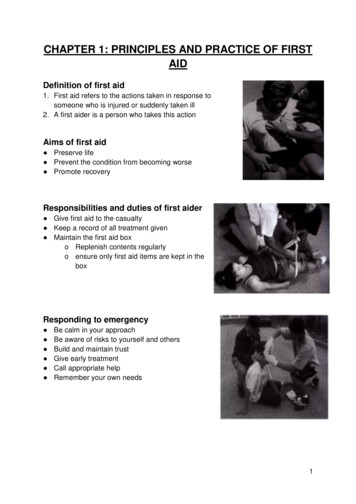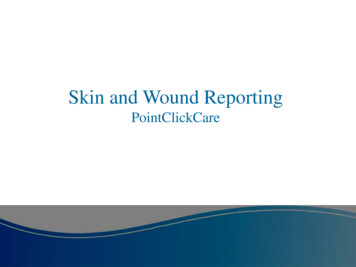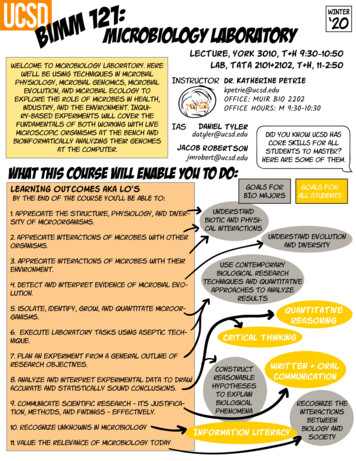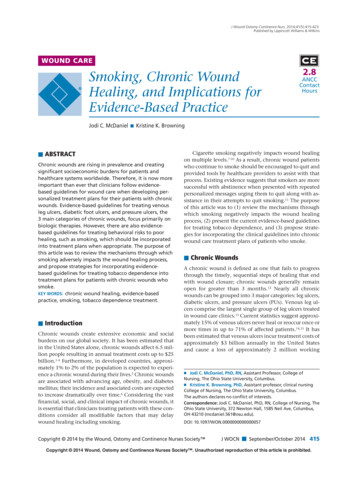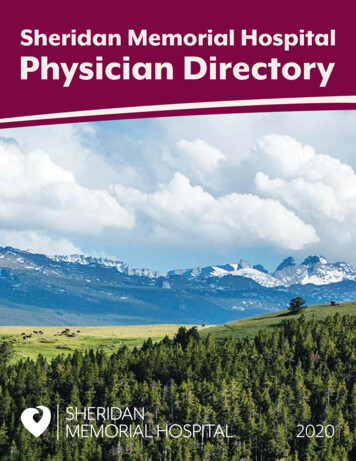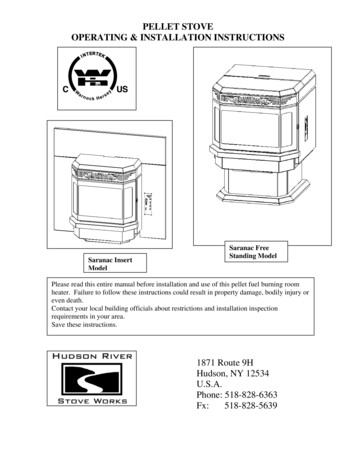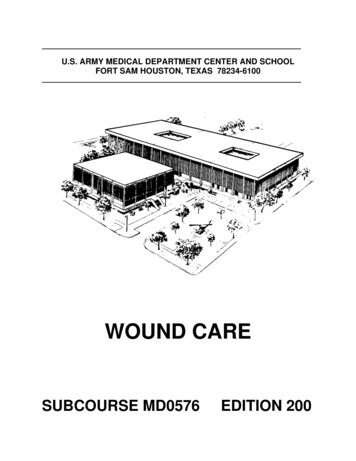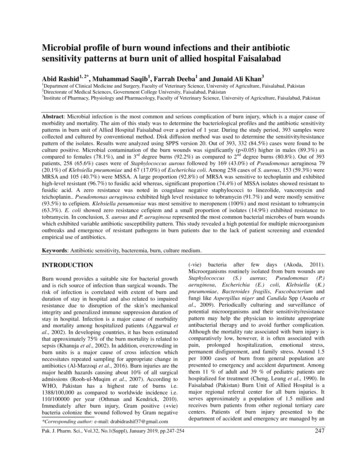
Transcription
Microbial profile of burn wound infections and their antibioticsensitivity patterns at burn unit of allied hospital FaisalabadAbid Rashid1, 2*, Muhammad Saqib1, Farrah Deeba1 and Junaid Ali Khan31Department of Clinical Medicine and Surgery, Faculty of Veterinary Science, University of Agriculture, Faisalabad, PakistanDirectorate of Medical Sciences, Government College University, Faisalabad, Pakistan3Institute of Pharmacy, Physiology and Pharmacology, Faculty of Veterinary Science, University of Agriculture, Faisalabad, Pakistan2Abstract: Microbial infection is the most common and serious complication of burn injury, which is a major cause ofmorbidity and mortality. The aim of this study was to determine the bacteriological profiles and the antibiotic sensitivitypatterns in burn unit of Allied Hospital Faisalabad over a period of 1 year. During the study period, 393 samples werecollected and cultured by conventional method. Disk diffusion method was used to determine the sensitivity/resistancepattern of the isolates. Results were analyzed using SPPS version 20. Out of 393, 332 (84.5%) cases were found to beculture positive. Microbial contamination of the burn wounds was significantly (p 0.05) higher in males (89.3%) ascompared to females (78.1%), and in 3rd degree burns (92.2%) as compared to 2nd degree burns (80.8%). Out of 393patients, 258 (65.6%) cases were of Staphylococcus aurous followed by 169 (43.0%) of Pseudomonas aeruginosa 79(20.1%) of Klebsiella pneumoniae and 67 (17.0%) of Escherichia coli. Among 258 cases of S. aurous, 153 (59.3%) wereMRSA and 105 (40.7%) were MSSA. A large proportion (92.8%) of MRSA was sensitive to techoplanin and exhibitedhigh-level resistant (96.7%) to fusidic acid whereas, significant proportion (74.4%) of MSSA isolates showed resistant tofusidic acid. A zero resistance was noted in coagulase negative staphylococci to linezolide, vancomycin andteichoplanin. Pseudomonas aeruginosa exhibited high level resistance to tobramycin (91.7%) and were mostly sensitive(93.5%) to cefipiem. Klebsiella penumoniae was most sensitive to meropenem (100%) and most resistant to tobramycin(63.3%). E. coli showed zero resistance cefipiem and a small proportion of isolates (14.9%) exhibited resistance totobramycin. In conclusion, S. aurous and P. aeruginosa represented the most common bacterial microbes of burn woundswhich exhibited variable antibiotic susceptibility pattern. This study revealed a high potential for multiple microorganismoutbreaks and emergence of resistant pathogens in burn patients due to the lack of patient screening and extendedempirical use of antibiotics.Keywords: Antibiotic sensitivity, bacteremia, burn, culture medium.INTRODUCTIONBurn wound provides a suitable site for bacterial growthand is rich source of infection than surgical wounds. Therisk of infection is correlated with extent of burn andduration of stay in hospital and also related to impairedresistance due to disruption of the skin‟s mechanicalintegrity and generalized immune suppression duration ofstay in hospital. Infection is a major cause of morbidityand mortality among hospitalized patients (Aggarwal etal., 2002). In developing countries, it has been estimatedthat approximately 75% of the burn mortality is related tosepsis (Khanuja et al., 2002). In addition, overcrowding inburn units is a major cause of cross infection whichnecessitates repeated sampling for appropriate change inantibiotics (Al-Marzoqi et al., 2016). Burn injuries are themajor health hazards causing about 10% of all surgicaladmissions (Rooh-ul-Muqim et al., 2007). According toWHO, Pakistan has a highest rate of burns i.e.1388/100,000 as compared to worldwide incidence i.e.110/100000 per year (Othman and Kendrick, 2010).Immediately after burn injury, Gram positive ( vie)bacteria colonize the wound followed by Gram negative*Corresponding author: e-mail: drabidrashif37@gmail.comPak. J. Pharm. Sci., Vol.32, No.1(Suppl), January 2019, pp.247-254(-vie) bacteria after few days (Akoda, 2011).Microorganisms routinely isolated from burn wounds areStaphylococcus (S.) aureus; Pseudomonas (P.)aeruginosa, Escherichia (E.) coli, Klebsiella (K.)pneumoniae, Bacteroides fragilis, Fuscobacterium andfungi like Aspergillus niger and Candida Spp (Asaolu etal., 2009). Periodically culturing and surveillance ofpotential microorganisms and their sensitivity/resistancepattern may help the physician to institute appropriateantibacterial therapy and to avoid further complication.Although the mortality rate associated with burn injury iscomparatively low, however, it is often associated withpain, prolonged hospitalization, emotional stress,permanent disfigurement, and family stress. Around 1.5per 1000 cases of burn from general population arepresented to emergency and accident department. Amongthem 11 % of adult and 39 % of pediatric patients arehospitalized for treatment (Cheng, Leung et al., 1990). InFaisalabad (Pakistan) Burn Unit of Allied Hospital is amajor regional referral center for all burn injuries. Itserves approximately a population of 1.5 million andreceives burn patients from other regional tertiary carecenters. Patients of burn injury presented to thedepartment of accident and emergency are managed by an247
Microbial profile of burn wound infections and their antibiotic sensitivity patternson-call general medical officer (MO) and patients that arein need of hospitalized treatment are reassessed by plasticsurgeon. The aim of this study is to determine thebacteriological profiles and the antibiotic sensitivitypatterns in burn unit of Allied Hospital Faisalabad over aperiod of 1 year.MATERIALS AND METHODSStudy designThis cross sectional study was conducted at Burn Unit ofAllied Hospital Faisalabad-Pakistan during the 12-monthperiod from February 2017 to January 2018.Population and data collectionThe inclusion criterion was the infection diagnosisaccording to the Centers for Disease Control (CDC)criteria (Horan et al., 2008). Data were collected througha standardized sheet of patient identification. The data ofeach patient including age, sex, type, degree and locationand extent of burn and other such parameters wererecorded. In this cross-sectional study, the S. aurous, P.aeruginosa, K. pneumoniae and E. coli isolates wereobtained from burn wounds of different sites admitted toBurn Unit of Allied Hospital Faisalabad-Pakistan. Thisstudy enrolled 393 cases having various forms of acuteburn injuries. The infection variables recorded positiveculture, type of germs and antibiotic treatment withpresence or absence of multi-resistant bacteria.Isolation and identification of microorganismsThe samples were collected in normal saline soaked swabusing „Z‟ fashion sampling technique from differentwound on day of patient admission. The swabs wereplaced in Brain Heart Infusion broths (with and withoutcefoxitin) and transported to the laboratory for isolationand identification. Briefly, the broth samples were preincubated at 37 C for 12 hours and plated on Blood,MacConkey and Pseudomonas cetrimide agar plates forisolation of selective pathogens. Methicillin resistant S.aureus (MRSA) were isolated by concentrationtechniques; pre-incubated BHI-cefoxitin broth sampleswere directly plated on MRSA CHROMagarTM(CHROMagar, Paris, France). Catalase positive, Grampositive colonies were presumptively identified asstaphylococci, which finally identified by tube coagulasetest (Tong et al., 2015) as S. aureus and coagulasenegative staphylococci (CNS). Mauve color colonies onCHROMagar were considered as MRSA. Theconfirmation of methicillin resistant and sensitive S.aureus (MSSA) was reached by cofixitin discsusceptibility method.For P. aeruginosa, yellow-green or yellow browncolonies that fluoresce under blue or UV light werepresumed. The confirmation was made by Gram staining,positive oxidase and citrate tests. Growth on MacConkey248agar was speciated as E. coli and K. pneumoniae byanalytical profile index 20E (bioMérieux, France).Antimicrobial susceptibility testingAntimicrobial susceptibility pattern for each isolates weredetermined by disk diffusion method (Kirby-Bauertechnique) on Muller Hinton agar (Oxoid) for pathogenspecific antimicrobials including aztreonem, amoxacillinclavulanic acid, ceftazidime, obactam,teichoplanin, tobramycin and vancomycin).STATISTICAL ANALYSISStatistical analyses were performed using the StatisticalPackage for the Social Science (SPSS), Version 20 forwindows. Continuous variables were summarized usingdescriptive statistics in terms of Chi square (χ2) test, 95%confidence intervals (95% CI), and p value 0.05 wasconsidered as significant.RESULTSOut of 393, 332 (84.5%) cases were found to be culturepositive. Bacterial isolation rate was significantly higher(0.002) in samples from males (89.3%) as compared tofemale (78.1%) patients. The patients above 70 years ofage were 100% culture positive. The isolation rate wassignificantly higher (p 0.002) in 3rd degree burn (92.2%)as compared to 2nd degree (80.8%). Rate of isolation washigher (86.2%) in samples taken from extremities ascompared to other anatomical locations. Nonetheless, thisdifference was non-significant statistically (p 0.741).Bacterial culture was more positive in unspecified burns(93.3%) as compared to other causes (p 0.496). Bacterialisolation rate was higher in patients with 30.1 to 50% totalbody surface area (TBSA; 91.4%) of burn as compared toother categories, however, this differed insignificantly(p 0.514). Positivity of a samples being positive washigher in died patients (89.5%) as compared to referred(86.7%) and discharged patients (83.2%), p 0.442 (table1).Staphylococcus aureus and coagulase negativeStaphylococciThree categories of staphylococci viz., methicillinresistant, methicillin sensitive S. aureus (MRSA andMSSA) and coagulase negative staph (CNS) wereidentified in wound swab cultures.Over all prevalence of MRSA, MSSA and CNS was 38.9,26.7 and 9.1 percent. Rate of isolation of MRSA andMSSA was significantly higher in males as compared tofemales (table-2).,MRSA culture was more positive inpatients above 70 years of age (50%) as compared toother groups, where, the corresponding group for MSSAwas 15.1-30 years of age. Prevalence of MRSA andMSSA was numerically higher in patients with 3rddegreePak. J. Pharm. Sci., Vol.32, No.1(Suppl), January 2019, pp.247-254
Abid Rashid et alburn (39.8 and 30.4 percent) as compared to 2nd degreeburn (38.5 and 26.0 percent). However, the prevalenceestimates were statistically insignificant. Isolation of bothMRSA and MSSA was higher in samples collected fromextremities in comparison to other anatomical locations.Similarly, electric burn wounds yielded more MRSA(54%) and MSSA (40%) than other burn types (table-2).This difference was statistically significant (p 0.015) forMRSA Approximately 43% MRSA were found in patientswith 50.1-70% TBSA in comparison to other categories.For MSSA, maximum isolation (35.7%) was recordedin15% TBSA. Isolation rate of MRSA was higher inreferred followed by died and discharged patients,whereas, MSSA was more prevalent in patients thatsuccumb to burns.The antibiotic susceptibility and resistance profile (fig. 1& 2) indicated that MRSA was most sensitive totechoplanin (92.8%) and was less sensitive to lincomycin(3.9%), imipenem (3.3%) and fusidic acid (3.3%). MRSAwas less resistant to teichoplanin (7.2%), vancomycin(7.9%) and linzolide (8.5%) and was more resistant tofusidic acid (96.7%), lincomycin (96.1%), imipenem(96.7%) and amoxicillin-Clavulanic acid (91.5%).The antibiotic susceptibility and resistance profile (fig. 1& 2) indicated that MSSA was most sensitive tovancomycin (100%) and less sensitive to imipenem(20.9%). MSSA was slightly resistant to linezolide (2.9%)and teichoplanin (3.8%) and was more resistant to fusidicacid (74.3), lincomycin (70.5%), imipenem (79.1%) andamoxicillin-clavulanic acid (78.1%). None of the MSSAisolates showed resistance to vancomycin.Fig. 2: Resistance (%) of the MRSA, MSSA and CNSagainst different antibioticsPseudomonas aeruginosaThe prevalence of P. aeruginosa was 43% and rate washigher in males (47.3%) than females (37.3%) whichdiffered significantly (p 0.046). Pseudomonas culturewas positive in 15.1-30 years of age patients (52.1%) withp value 0.506. Pseudomonas culture was more positive inpatients with third degree burn (44.5%) as compared to2nd degree burn (42.3) with p value 0.671. Pseudomonasculture was more positive in head and neck (47.3%) withp value 0.573. Pseudomonas culture was more positive inchemical burns (53.1%) with p value 0.732. Pseudomonasculture was more positive in less than 15% extent of burn(46.4%) with p value 0.649. Pseudomonas culture wasmore positive in discharged patients (43.6%) as comparedto referred (40%) and died patients (42.1%) with p value0.890 (table 2).Fig. 3: Sensitivity (%) of the Pseudomonas aeruginosa,K. penumoniae and E. coli against different antibiotics.Fig. 1: Sensitivity (%) of the MRSA, MSSA and CNSagainst different antibiotics.Coagulase negative staphylococci (CNS)Antimicrobial susceptibility pattern of CNS revealed lowlevel resistance to imipenem (8.3%), followed by fusidicacid (11.1%) and lincomycin (30.6%). However, asignificant proportion (41.7%) of CNS was resistant toamoxicillin-clavulanic acid. A zero resistance wasregistered to linezolide, vancomycin and teichoplanin.Pak. J. Pharm. Sci., Vol.32, No.1(Suppl), January 2019, pp.247-254The antibiotic susceptibility and resistance profile (figs. 3& 4) indicated Pseudomonas aeruginosa was mostsensitive to cefipiem (93.5%), dorepenem (92.9%) andmeropenum (88.2%) and was less sensitive to tobramycin(8.28%). Pseudomonas was most resistance to tobramycin(91.7%) and least resistant to cefipiem (6.5%).Klebsiella pneumoniaeK. pneumoniae culture was more positive in female(23.7%) as compared to male (17.4%) with p value 0.125.K. pneumoniae culture was positive in 4.1-15 years of age249
Microbial profile of burn wound infections and their antibiotic sensitivity patternspatients (23.3%) with p value 0.877. K. pneumoniaeculture was more positive in patients with third degreeburn (22.7%) as compared to 2nd degree burn (18.9%)with p value 0.380. K. pneumoniae culture was morepositive in upper part of body (27.9%) with p value 0.487.K. pneumoniae culture was more positive in unspecifiedburns (40%) with p value 0.091. K. pneumoniae culturewas more positive in 50.1-70% and above 70% extent ofburn (21.4%). K. pneumoniae culture was more positivein referred patients (28.9%) as compared to discharged(18.2) and died patients (22.8%) with p value 0.216 (table2).Fig. 4: Resistance (%) of the Pseudomonas aeruginosa,K. penumoniae and E. coli against different antibioticsThe antibiotic susceptibility and resistance profile (fig. 3& 4) indicated K. penumoniae was most sensitive toMeropenem (100%) and dorepenem (100%) and was lesssensitive to tobramycin (36.7%). K. pneumoniae is mostresistant to tobramycin (63.3%) and least resistant tocefipiem (5.1%).Escherichia coli (E. coli)E. coli culture was more positive in female (21.3%) ascompared to male (13.8%) with p value 0.051. E. coliculture was positive in 4.1-15 years of age patients(18.5%) with p value 0.981. E. coli culture was morepositive in patients with third degree burn (34.4%) ascompared to 2nd degree burn (8.7%) with p value 0.001.E. coli culture was more positive in head and neck(20.5%) with p value 0.514. E. coli culture was morepositive in accidental burns (35.7) with p value 0.498. E.coli culture was more positive in more than 50.1-70%extent of burn (45.2%) with p value 0.001. E. coli culturewas more positive in died patients (43.9%) as comparedto discharged (11.7%) and referred patients (17.8%) withp value 0.001 (table 2).None of the isolates exhibited zero resistance to azobactam, and aztreonem. A slight resistance was notedto tobramycin (14.9%) followed by ceftazidime (9%),moxifloxacin (6%) and imipenem (2%).250DISCUSSIONBurn is one of the most common and devastating forms oftrauma (Kuang, Li et al., 2018). Patients with severe burninjury require immediate specialized care in order tominimize morbidity and mortality (Benariba, Djaziri etal., 2013). In the past few decades, although survival ratesof burn have improved substantially due to advances inmodern medical care in specialized burn centers.However nosocomial infections represent a majorchallenge for a burn team in burn patients, which are amajor cause (over 50%) of burn deaths. In the world, burnis considered one of the major health problems. S. aureuswas the most commonly recognized microbe in burnpatients in agreement to our study, some previous studiesshow that most common microbe of burn wound was S.aureus (Clark, 1996, Conforti, Statti et al., 2007). Ourstudy is also similar to another study conducted in burnunit in Shafiq Aziz Burn Hospital, Lahore, Pakistan thatshowed S. aureus was most abundant strains (Swallow,2003). In contrast to other study conducted at Burn CareCentre, Pakistan Institute of Medical Sciences (PIMS),Islamabad showed that most frequent isolates found wasPseudomonas aeruginosa (Solomons, 2003). In anotherstudy showed that S. aureus is the most common isolate(Abdel-Wahhab and Ahmed, 2004). The 2nd most commonorganism in burn patients was P. aeruginosa. Our findingsdiffers from previous studies in which P. aeruginosa wasmost common organism found in burn patients (Buleandraet al., 2016, Chong-Zhi et al., 2016). P. aeruginosa issuggested to be the 2nd most important cause of infectionamong burn patients as it has the capacity to grow onmoist surfaces, particularly burn wounds, which is theultimate setting for infectivity and colonization of this P.aeruginosa. P. aeruginosa was most sensitive to cefipiemand dorepenem and was less sensitive to tobramycin(DeRisi et al., 1997).The 3rd most common identified microbe in our studieswas K peneumoniae, in contrast to previous studies inwhich 2nd most commonest cultured organism was K.peneumoniae (Cui et al., 2014). However, in otherstudies, K. peneumoniae was reported as the mostcommon organism of burn infection (Cui et al., 2014,Dashwood, 2002).K. pneumoniae was most sensitive to meropenem anddorepenem and was less sensitive to tobramycin. E. coliwas most sensitive to cefipenem, meropenem, dorepenem,imipenum, piperacillin-tazobactam, aztreonem and wasless sensitive to tobramycin. K. pneuumoniae and E. coliis sensitive to imipenem, ceftazidime and tobramycin. E.coli, K. pneumoniae and P. aeruginosa is sensitive ctam, aztreonem and moxifloxacin. Pseudomonaswas most resistance to tobramycin and least resistant tocefipiem. K. pneumoniae is most resistant to tobramycinPak. J. Pharm. Sci., Vol.32, No.1(Suppl), January 2019, pp.247-254
Abid Rashid et alTable 1: Number and percentage of the different variables with reference to the bacterial culture of burn cases in thepatients presented at burn unit of allied hospital, Faisalabad, PakistanVariableGenderAge GroupDegree of BurnAnatomical LocationCause of BurnExtent of BurnOutcomeCategoryFemaleMaleUp to 4 Years4.1 to 15 Years15.1 to 30 Years30.1 to 69 YearsAbove 70 Years2nd degree3rd DegreeExtremitiesHead and NeckLower part of bodyUpper Part of BodyAccidental BurnAcid BurnChemical BurnElectric BurnFlame BurnRadiation BurnScald BurnUnspecified 15.0%15.1-30.0%30.1-50.050.1-70.0% 70.0%DischargedReferredDiedand least resistant to cefipiem. No resistance occurred byused of meropenem and durepenem. E. coli showedresistance by use of tobramycin and no resistance wasseen in case of other antibiotics. Resistance (%) of the P.aeruginosa and E. coli against tobramycin is 91.7% and14.9% respectively. In the case of pseudomonalinfections, most common prescribed antibiotic isceftazidime, however in current study resistance of the P.aeruginosa against ceftazidime is 37.6%. With this proofbase in mind, we can revise our guidelines of empiricantibiotic therapy for our burn patients with sepsis.In our study, pseudomonas was most sensitive tocefipeim, meropenem and dorepenem (fig. 3) and leastresistant to cefipeim, meropenem and dorepenem (fig. 4).MRSA and MSSA was most sensitive to linzolide,vancomycin and teichoplaninIn our study, resistance of the P. aeruginosa againstimipenem, moxifloxacin, azotreonem and piperacillintazobactum is 78%, 58.9%, 58% and 52.7% respectively.This study is in accordance with previous study in whichPak. J. Pharm. Sci., Vol.32, No.1(Suppl), January 2019, /27432/3538/4211/14242/29139/4551/57Culture PositivePositive % (95% CI)78.1 (71.1-84.1)89.3 (84.5-93)80.6 (71.6-87.7)85.4 (77.1-91.6)89.7 (80.2-95.8)83.3 (75.2-89.7)100 (39.8-100)80.8 (75.5-85.3)92.2 (86.1-96.2)86.2 (79-91.6)84.8 (76.8-90.9)84.3 (76-90.6)79.1 (64-90)78.6 (49.2-95.3)86.9 (66.4-97.2)90.6 (75-98)92 (80.8-97.8)80.7 (73.2-86.9)87.5 (61.7-98.4)82.5 (73.8-89.3)93.3 (68.1-99.8)82.1 (63.1-93.9)83.2 (78.2-87.4)91.4 (46.9-98.2)90.5 (77.4-97.3)78.6 (49.2-95.3)83.2 (78.4-87.3)86.7 (73.2-94.9)89.5 (78.5-96)p Valueχ2 9.181p 0.002χ2 3.635p 0.458χ2 8.604p 0.003χ2 1.252p 0.741χ2 6.381p 0.496χ2 3.266p 0.514χ2 1.634p 0.442P. aeruginosa was found resistant to 10 antibioticspectrums (glycylcyline and quinolones, phenicol,sulfonamide, carbapenem, monobactam and penicillin beta lactamase inhibitors (De Fátima Navarro, De Souzaet al., 2002).In this study MRSA instituted an alarmingly highpercentage (n 153/258 59.30%) of the staphylococcalisolates. As the reservoirs of MRSA are not only presentin hospital but also large reservoirs also exist outside thehealthcare facilities. Patients of burn injury aresusceptible to both health care-associated MRSA (HAMRSA) infections as well as the community associatedMRSA (CA-MRSA). Infection of MRSA usually followscarriage of microorganism for some period. In theepidemiology of MRSA “5 Cs”: contact with infectedcases, Contaminated fomites, Compromised skin,Cleanliness and Crowded living together with priorantibiotic are all important. Adaptation of standarduniversalrulesofcontactprecautions,251
Microbial profile of burn wound infections and their antibiotic sensitivity patterns252Pak. J. Pharm. Sci., Vol.32, No.1(Suppl), January 2019, pp.247-254
Abid Rashid et alhand hygiene and barrier nursing by all hospital personnelcan effectively prevent the cross infection amonghospitalized patients (David and Daum, 2010)In this study, MRSA was most sensitive to linezolide andwas less sensitive to lincomycin, imipenem and fusidicacid. MSSA was most sensitive to vancomycin and lesssensitive to imipenem. CNS was most sensitive againstlinezolide, vancomycin and teichoplanin and was lesssensitive against amoxicillin-clavulanic acid. Sensitivity(%) of the MRSA, MSSA and CNS against vancomycin is92.1, 100 and 100 respectively. Sensitivity of the MRSA,MSSA and CNS against linzolide is 91.5%, 97.1% and100% respectively. Sensitivity (%) of the MSSA and CNSagainst fusidic acid is 25.7 and 88.9 respectively.Sensitivity (%) of the MSSA and CNS against imipenemis 20.9, 91.7 respectively. Sensitivity (%) of the MSSAand CNS against lincomycin is 29.5 and 69.4 respectively.Sensitivity (%) of the MSSA and CNS againstAmoxacillin-clavulanic acid is 21.9% and 58.3%respectively. linzolide and vancomycin has shown thehigher sensitivity pattern demonstrated by MRSA, MSSAand CNS as compared to other antibiotics such aslincomycin, imipenem, fusidic acid, imipenem,amoxicillin-clavulanic acid.MRSA was less resistant to linezolide, vancomycin andteichoplanin and was more resistant to Fusidic acid,lincomycin, imipenem and amoxicillin-clavulanic acid.MSSA was slightly resistant to Linezolide andteichoplanin and was more resistant to Fusidic acid,lincomycin, imipenem and amoxicillin-clavulanic acid.MSSA showed no resistance to vancomycin. CNS shoedno resistance to linezolide, vancomycin and teichoplaninand was more resistant to Fusidic acid, lincomycin,imipenem and amoxicillin-clavulanic acid.Resistance (%) of the MRSA, MSSA and CNS againstfusidic acid is 96.7, 74.3 and 11.1 respectively. Resistance(%) of the MRSA, MSSA and CNS against linzolide is8.5, 2.9 and 0.00 respectively. Resistance (%) of theMRSA, MSSA and CNS against vancomycin is 7.9, 0.00and 0.00 respectively. Resistance (%) of the MRSA,MSSA and CNS against teichoplanin is 7.2, 3.8 and 0respectively. Resistance (%) of the MRSA, MSSA andCNS against amoxacillin-clavulanic acid is 91.5, 78.1 and41.7 respectively. Resistance (%) of the MSSA and CNSagainst lincomycin is 96.1, 70.5 and 30.6% respectively.Resistance (%) of the MSSA and CNS against imipenemis 96.7, 79.1 and 8.3% respectively.Teichoplanin was the most potent (92.8%) antimicrobialagents against MRSA followed by vancomycin (92.1%)whereas vancomycin was most effective against MSSAfollowed by linezolid (2.9%). And in case of CNS,linzolide, vancomycin and teichoplanin, all are effective(100%) followed by imipenem (8.3%).Pak. J. Pharm. Sci., Vol.32, No.1(Suppl), January 2019, pp.247-254It was revealed that MRSA showed equal resistance(96.7%) to each fusidic acid and Imipenem followed bylincomycin (96.1%), amoxicillin-clavulanic acid (91.5%),linezolide (8.5%), vancomycin (7.9%) and teichoplanin(7.2%).Considering the high resistance rate in our study, it maybe assumed that the unsuccessful treatment of burnpatients is a consequence of high mortality. Antibioticresistance in burn patients prolongs illness and increaseshealth care cost hence complicates the treatment whichultimately happens a serious life-threatening condition forthe patient (Dhingra et al., 2004). This is particularlyimportant in Pakistan where antibiotics are prescribedwithout laboratory guidance as well as over the countersales of antibiotics is common practices. This studyrevealed a high potential for multiple microorganismsoutbreaks and emergence of resistant pathogens in burnpatient‟s due to lack of patients screening and extendedempirical use of antibiotics. This indicates the necessity toimplement a system of antibiotic stewardship andinfection prevention where microbiological diagnosticsresults are made available to physician for bettermanagement of burn patients.CONCLUSIONCurrent research will be supportive in providing usefulstrategy for selecting successful empirical therapy whichwill have enormous impact on reducing mortality andmorbidity of burn patients due to septicemia/bacteremia.We also suggest that prevalent micro flora, their resistanceand sensitivity pattern should be studied for prevention ofthe emergent multi drug resistant strains, due to ofhaphazard utilization of antibiotics. Treatment of MRSAinfection requires prompt source control and initiation anain remains the initial antibiotic of choice forthe treatment of MRSA infection as it shows almostsimilar results.ACKNOWLEDGEMENTSAuthors are thankful to Department of Clinical Medicine andSurgery, Faculty of Veterinary Science, University ofAgriculture, Faisalabad for providing technical support forcarrying out this research.REFERENCESAbdel-Wahhab MA and Ahmed HH (2004). Protectiveeffect of korean panax ginseng against chromiumtoxicity and free radicals generation in rats. J. GinsengRes., 28(1): 11-17.Aggarwal K, Khanuja S, Ahmad A, Santha Kumar T,Gupta VK and Kumar S (2002). Antimicrobial activityprofiles of the two enantiomers of limonene and253
Microbial profile of burn wound infections and their antibiotic sensitivity patternscarvone isolated from the oils of Mentha spicata andAnethum sowa. Flav. Fragr. J., 17(1): 59-63.Akoda WE (2011). Traditional African medicine and thebenedictine monks: A discourse. Amer. J. Soc. Issu.Humanit., 1(2): 137-157.Al-Marzoqi AH, Hadi MY and Hameed IH (2016).Determination of metabolites products by Cassiaangustifolia and evaluate antimicobial activity. J.Pharmacogn. Phytother., 8(2): 25-48.Asaolu M, Oyeyemi O and Olanlokun J (2009). Chemicalcompositions, phytochemical constituents and in vitrobiological activity of various extracts of Cymbopogoncitratus. Pak. J. Nutr., 8(12): 1920-1922.Ashraf M and Harris P (2004). Potential biochemicalindicators of salinity tolerance in plants. Plant Sci.,166(1): 3-16.Benariba N, Djaziri R, Bellakhdar W, Belkacem N,Kadiata M, Malaisse WJ and Sener A (2013).Phytochemical screening and free radical scavengingactivity of Citrullus colocynthis seeds extracts. AsianPac. J. Trop. Biomed., 3(1): 35.Buleandra M, Oprea E, Popa DE, David IG, Moldovan Z,Mihai I and Badea IA (2016). Comparative chemicalanalysis of Mentha piperita and M. spicata and a fastassessment of commercial peppermint teas. Nat.Poduct. Communic., 11(4): 551-555.Cheng J, Leung K, Lam ZL and Leung P (1990). Ananalysis of 1704 burn injuries in Hong Kong children.Burns, 16(3): 182-184.Chong-Zhi W, Anderson S, Wei D, Tong-Chuan H andChun-Su Y (2016). Red ginseng and cancer treatment.Chinese J. Nat. Med., 14(1): 7-16.Clark AM (1996). Natural products as a resource for newdrugs. Pharm. Res., 13(8): 1133-1141.Conforti F, Statti GA and Menichini F (2007). Chemicaland biological variability of hot pepper fruits(Capsicum annuum var. acuminatum L.) in relation tomaturity stage. Food Chem., 102(4): 1096-1104.Cui ZG, Piao JL, Rehman MU, Ogawa R, Li P, Zhao QL,Kondo T and Inadera H (2014). Molecular mechanismsof hyperthermia-induced apoptosis enhanced bywithaferin A. Europ. J. Pharmacol., 723: 99-107.Dashwood RH (2002). Modulation of heterocyclic amineinduced mutagenicity and carcinogenicity: An „A-toZ‟guide to chemopreventive agents, promoters, andtransgenic models. Mutation Res./Re
MRSA and 105 (40.7%) were MSSA. A large proportion (92.8%) of MRSA was sensitive to techoplanin and exhibited high-level resistant (96.7%) to fusidic acid whereas, significant proportion (74.4%) of MSSA isolates showed resistant to . sex, type, degree and location and extent of burn and other such parameters were recorded. In this cross .
